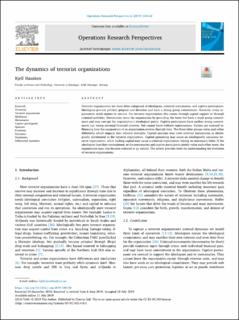| dc.contributor.author | Hausken, Kjell | |
| dc.date.accessioned | 2023-01-24T14:23:47Z | |
| dc.date.available | 2023-01-24T14:23:47Z | |
| dc.date.created | 2019-07-10T23:13:02Z | |
| dc.date.issued | 2019 | |
| dc.identifier.citation | Hausken, K. (2019). The dynamics of terrorist organizations. Operations Research Perspectives, 6, 100120. | en_US |
| dc.identifier.issn | 2214-7160 | |
| dc.identifier.uri | https://hdl.handle.net/11250/3045914 | |
| dc.description.abstract | Terrorist organizations are most often comprised of ideologues, criminal mercenaries, and captive participants. Ideologues provide political purpose and direction and have a strong group commitment. However, every organization needs money to survive. For terrorist organizations this comes through capital support or through criminal activities. Mercenaries serve the organization by providing the latter but have a weak group commitment and may corrupt the organization‘s ideological purity. Captive participants have neither strong commitments nor strong personal financial interests, but cannot leave without repercussions. Factors are assessed influencing how the composition of an organization evolves through time. The three labor groups value each other differently which impacts their relative strengths. Capital sponsors may view criminal mercenaries as ideologically detrimental to the terrorist organization. Capital sponsoring may cause an ideologically conscious terrorist organization, while lacking capital may cause a criminal organization relying on mercenary labor. If the ideologues lose their commitment, or the mercenaries and captive participants jointly value each other more, the organization may also become criminal or go extinct. The article provides tools for understanding the evolution of terrorist organizations. | en_US |
| dc.language.iso | eng | en_US |
| dc.publisher | Elsevier | en_US |
| dc.rights | Navngivelse 4.0 Internasjonal | * |
| dc.rights.uri | http://creativecommons.org/licenses/by/4.0/deed.no | * |
| dc.title | The Dynamics of Terrorist Organizations | en_US |
| dc.type | Peer reviewed | en_US |
| dc.type | Journal article | en_US |
| dc.description.version | publishedVersion | en_US |
| dc.rights.holder | The authors | en_US |
| dc.subject.nsi | VDP::Samfunnsvitenskap: 200 | en_US |
| dc.source.pagenumber | 14 | en_US |
| dc.source.volume | 6 | en_US |
| dc.source.journal | Operations Research Perspectives | en_US |
| dc.identifier.doi | 10.1016/j.orp.2019.100120 | |
| dc.identifier.cristin | 1711155 | |
| cristin.ispublished | true | |
| cristin.fulltext | original | |
| cristin.qualitycode | 1 | |

